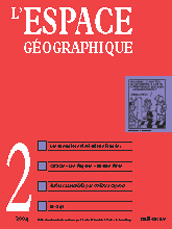

Guénola CAPRON. Gated communities in the Americas: a critical reading of the literature
This paper aims to establish a critical reading of the literature on gated communities from the United States and Latin America versus that from France, looking at recurring themes. On the basis of this comparison, we propose a reflection on the relationship, in the Americas, between the processes of enclosure, security, independence, and, ultimately, homogenisation, which seems to be one of the major trends in the evolution of the city.
keywords: DWELLING, FRAGMENTATION, RESIDENTIAL HOMOGENEISATION, SECURITY, URBAN SECESSION
Pedro José GARCÍA SÁNCHEZ. Private urban communities: security and socio-spatial homogenisation in Caracas (3 fig., 4 photos)
Private urban communities began to develop in Caracas in the late 1980s. Instrumental in this trend is the intensification of a process of segregation based on security. A segmentary territorial configuration is emerging, shaped by certain figures of interaction: community participation, sociability of surveillance, the privatisation of public space and urban discretion. An analysis of this configuration, increasingly present in the contemporary redefinition of the urban geography of Caracas, highlights they way in which uses are shaping day-to-day socio-spatial homogenisation in some residential communities.
keywords: CARACAS, CITIZENSHIP, COMMUNITY PARTICIPATION, SOCIO-SPATIAL HOMOGENISATION, TERRITORIALISATION, URBAN COMMUNITIES
Julie-Anne BOUDREAU, Sophie DIDIER, Claire HANCOCK. Residential homogenisation and political independence: secession and incorporation of cities in Los Angeles. (1 tabl., 4 fig., 3 photos, 1 encadré)
This article discusses the common assumption that districts are being homogenised, whether they are identified as gated communities or not. There would thus seem to be an almost inevitable link in the fairly near term between residential homogeneousness and political independence, spurring a trend towards urban fragmentation in large metropolises. Through the analysis of three case studies in Los Angeles on three different scales (the secession of San Fernando Valley and Hollywood, and the incorporation of Leisure World), we examine the validity of that link. We show in particular that the correlation is not obvious on every scale of analysis and that it is important to distinguish between discourse and factual situations of homogeneousness.
keywords: HOMOGENIZATION, INCORPORATION, INDEPENDENCE, LOS ANGELES, SECESSION
Mónica LACARRIEU, Guy THUILLIER. A utopia of order and enclosure: private districts and countries in Buenos Aires (2 fig.)
A comparison of the objective data of the historical development and market characteristics of gated communities in Buenos Aires with residents opinions on enclosure and security, themes at the heart of vernacular names and promotional policies for these urban objects, makes it possible to go beyond the normative criticisms too often based on a mere description of forms. Deconstruction of the object offers a better understanding of the social and urban logics associated with it in the large metropolises of Latin America.
keywords: BUENOS AIRES, GATED COMMUNITIES, URBANISM
Bernard ROLAND, Cyril FLEURANT. Using fractal geometry to characterise hedgerow lattice (2 tabl., 5 fig.)
The hedgerow landscape has changed radically over the past fifty years in line with agricultural development. The shape of the hedgerow lattice has numerous effects, for example, on the hydrological and ecological functions of the landscape. We have therefore attempted to characterise the network structure using fractal geometry. The box-counting method makes it possible to obtain significantly different results when analysing this structure using fractal parameters (dimension, upper and lower cut-offs).
keywords: BOX-COUNTING METHOD, FRACTAL GEOMETRY, HEDGEROW LATTICE, HEDGEROW LANDSCAPE
The impossible reconstruction of destroyed hedgerows. When changes in social perceptions associated with hedgerows explain the failure of hedge-replanting policies in land consolidation zones in south-eastern Ille-et-Vilaine. (2 fig., 5 photos)
To reconcile the needs of Breton farmers and the public authorities, land consolidation was long considered as an almost providential tool. Then in the mid-1970s, in an attempt to reverse the serious damage done to the environment and landscapes, the Regional Council and Chamber of Agriculture in Ille-et-Vilaine launched a major programme to replant hedges. This about-face was particularly unpopular in the consolidated zones since they had until then been held up as an example to follow. Twenty-five years on, it is worth investigating the reasons for this failure.
keywords: FARMERS, HEDGEROWS, ILLE-ETVILAINE, PUBLIC POLICY, SOCIAL PERCEPTION
Book reviews
In this issue of l’Espace géographique, you will find critical reviews of the following books
BURGEL Guy (2002). Le Miracle athénien au XXe siècle. Paris: CNRS Éditions, coll. «CNRS/PLUS», 365 p. (par Jean-Bernard Racine, Université de Lausanne)
PELLETIER Monique (2002). Les Cartes de Cassini, la science au service de L’État et des régions. Paris: CTHS, 338 p. (par Bernard Debarbieux, Université de Genève)
WHATMORE Sarah (2002). Hybrid Geographies. Natures Cultures Spaces. Londres: Sage, 225 p., ISBN 0 7619 6567 X, paperback, £18.99. (par Véronique FOURAULT, Université de Paris 1, et Olivier MILHAUD, University of Bristol)
Lespace géographique 1/04![]()
![]() L’espace géographique 3/04
L’espace géographique 3/04
For subscribe or buy this issue: BELIN
![]() L’Espace géographique: contents
L’Espace géographique: contents
Last modified: June 16, 2004